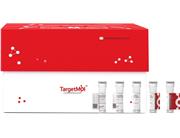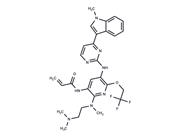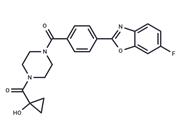| Name | Rifapentine |
| Description | Rifapentine (Rifapentinum) is a long-acting, cyclopentyl-substituted derivative of rifamycin used to treat mycobacterium infections. |
| In vitro | Rifapentine inhibits the function of DNA-dependent RNA polymerase in strains of M. tuberculosis, while inducing no effect on mammalian cells. Both Rifapentine and its active metabolite, 25-desacetylrifapentine, localize within monocyte-derived macrophages, thus allowing for intracellular inhibition of M. tuberculosis at a greater kill rate as compared with that of the parent or metabolite alone. Rifapentine is deacetylated in the liver and induces cytochrome P450 much less than rifampin. [1] Rifapentine has shown higher bacteriostatic and bactericidal activities (MICs and MBCs) than RMP, especially against intracellular bacteria growing in human monocyte-derived macrophages. [2] |
| In vivo | Rifapentine inhibits bacterial RNA synthesis by binding to the β-subunit of DNA-dependent RNA polymerase in susceptible species. Rifapentine is generally more active than rifampicin against sensitive strains of M. tuberculosis. [3] Rifapentine significantly increases the rate of antipyrine and pentobarbital metabolism in vivo. Rifapentine also increases liver weight, the content of liver microsomal protein and cytochrome P-450, the activity of NADPH-cytochrome C reductase and NADPH oxidase. [4] Rifapentine combined with isoniazid (INH) and pyrazinamide (PZA) administered daily results in an apparent clearance of M.tuberculosis organisms in the lungs and spleens of infected mice after 10 weeks of treatment. [5] |
| Storage | Powder: -20°C for 3 years | In solvent: -80°C for 1 year | Shipping with blue ice/Shipping at ambient temperature. |
| Solubility Information | DMSO : 93 mg/mL (106.04 mM), Sonication is recommended.
10% DMSO+40% PEG300+5% Tween 80+45% Saline : 3.3 mg/mL (3.76 mM), Sonication is recommended.
H2O : < 1 mg/mL (insoluble or slightly soluble)
Ethanol : 14 mg/mL (15.96 mM), Sonication is recommended.
|
| Keywords | RNASynthesis | RNA Synthesis | RNA polymerase | Rifapentine | MDL-473 | MDL 473 | Inhibitor | inhibit | DNASynthesis | DNA Synthesis | DL-473 | DL473 | Bacterial | Antibiotic |
| Inhibitors Related | Neomycin sulfate | Dehydroacetic acid sodium | Ampicillin sodium | Methyl anthranilate | Kanamycin sulfate | Urethane | Sulfamethoxazole sodium | Guanidine hydrochloride | Doxycycline | Thymidine | Isoeugenol | Dimethyl sulfoxide |
| Related Compound Libraries | Failed Clinical Trials Compound Library | Bioactive Compound Library | Anti-Cancer Clinical Compound Library | Drug Repurposing Compound Library | Anti-Cancer Approved Drug Library | FDA-Approved Drug Library | Orally Active Compound Library | Immunology/Inflammation Compound Library | Anti-Aging Compound Library | Clinical Compound Library | Bioactive Compounds Library Max | Anti-Cancer Drug Library |

 United States
United States






